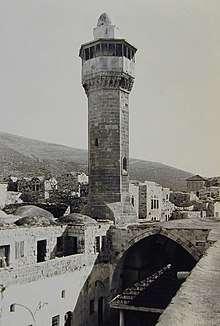Great Mosque of Nablus
Great Mosque of Nablus (Arabic: جامع نابلس الكبير Jami' Nablus al-Kebir) is the oldest and largest mosque in the Palestinian city of Nablus.[1] It was originally built as a Byzantine church and was converted into a mosque during the early Islamic era. The Crusaders transformed it into a church in the 11th century, but it was reconsecrated as a mosque by the Ayyubids in the 12th century. The mosque is located at the intersection of the main streets of the Old City, along the district's eastern edges.[2] It has a long, narrow, rectangular floor plan and a silver dome.[3]
| Great Mosque of Nablus | |
|---|---|
 The Great Mosque's minaret | |
| Religion | |
| Affiliation | Islam |
| District | Old City |
| Province | West Bank |
| Region | Levant |
| Year consecrated | 1187 |
| Location | |
| Location | |
| Architecture | |
| Type | Mosque |
| Style | Early Arab, Ayyubid |
| Completed | Tenth century CE |
| Specifications | |
| Dome(s) | 1 |
| Minaret(s) | 1 |
History
Local legend in Nablus claims that mosque was the site where Jacob's sons handed Jacob the blood-stained coat of their brother Joseph as evidence that his favorite son was dead.[1] This tradition is more associated with the nearby al-Khadra Mosque, however.
The site of the Great Mosque was originally a basilica built during the reign of Philip the Arab in 244-249 CE.[3] The Byzantines later constructed a cathedral on the basilica's ruins and this cathedral is depicted in the mosaic Map of Madaba in 600 CE.[4] It was likely damaged or destroyed by the Samaritans during their raids in 484 and 529, but Emperor Justinian I (reigned from 483-565) had the cathedral restored.[5]
The cathedral was transformed into the Great Mosque of Nablus in the early period of Islamic Arab rule in Palestine, in the 10th-century.[6] Arab geographer al-Muqaddasi wrote that the Great Mosque was in the “midst” of Nablus, and “is very finely paved.”[7] The Crusaders reconverted the mosque into a church, but made only few alterations including the construction of an apse. In 1187, the Ayyubids led by Saladin converted the building as a mosque again. The building was burned down by the Knights Templar in the sack of the city of 30 October 1242.[5]
A new building was present by the end of the 13th century, as evidenced by Arab chronicler al-Dimashqi who, in 1300, mentions the Great Mosque as “a fine mosque, in which is prayer is said, and the Qur'an recited day and night, men being appointed thereto.”[8] In 1335, Western traveler James of Verona recorded that the mosque had been “a church of the Christians but now is a mosque of the Saracens.”[5] Twenty years later, Ibn Batuta visited it and noted that in the middle of the mosque was a “tank of sweet water.”[9]
In 1641, the Great Mosque's minaret was rebuilt,[10] but the mosque compound had remained virtually untouched throughout most of its later existence until a severe earthquake struck Palestine, especially Nablus in 1927. The mosque's dome and minaret were destroyed as a result, but were restored in 1935.[3]
References
- Dumper, Stanley and Abu-Lughod, 2007, p.267.
- Places to Visit General Mission of Palestine-Tokyo.
- Semplici, Andrea and Boccia, Mario. - Nablus, At the Foot of the Holy Mountain Archived 2017-07-08 at the Wayback Machine Med Cooperation, pp.15-16.
- Pringle, 1998, p. 97
- Pringle, 1998, p. 98
- Dumper, Stanley and Abu-Lughod, 2007, p.266.
- al-Muqaddasi quoted in le Strange, 1890, p.511.
- al-Dimashqi quoted in le Strange, 1890, p.513.
- Ibn Batuta quoted in le Strange, 1890, p.514.
- Nablus Archived 2016-03-03 at the Wayback Machine Nablus Guide.
Bibliography
| Wikimedia Commons has media related to Great Mosque of Nablus. |
- Clermont-Ganneau, C.S. (1899). [ARP] Archaeological Researches in Palestine 1873-1874, translated from the French by J. McFarlane. 1. London: Palestine Exploration Fund. (p. 26)
- Clermont-Ganneau, C.S. (1896). [ARP] Archaeological Researches in Palestine 1873-1874, translated from the French by J. McFarlane. 2. London: Palestine Exploration Fund. (pp. 311-312)
- Dumper, Michael (2007). Cities of the Middle East and North Africa: A Historical Encyclopedia. ABC-CLIO. ISBN 1-57607-919-8.
- Conder, C.R.; Kitchener, H.H. (1882). The Survey of Western Palestine: Memoirs of the Topography, Orography, Hydrography, and Archaeology. 2. London: Committee of the Palestine Exploration Fund. (p. 203)
- Pringle, Denys (1998). The Churches of the Crusader Kingdom of Jerusalem: L-Z (excluding Tyre). Cambridge University Press. ISBN 0-521-39037-0.
- Strange, le, G. (1890). Palestine Under the Moslems: A Description of Syria and the Holy Land from A.D. 650 to 1500. Committee of the Palestine Exploration Fund. ISBN 0-404-56288-4., London,